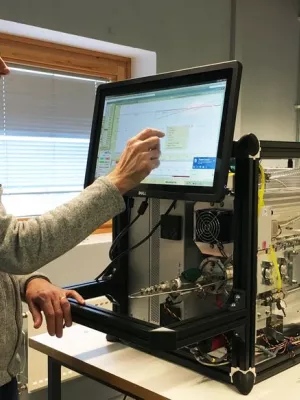
Erik Swietlicki
Professor

Cloud droplet nucleation scavenging in relation to the size and hygroscopic behaviour of aerosol particles
Författare
Summary, in English
The size distributions and hygroscopic growth spectra of aerosol particles were measured during the GCE cloud experiment at Great Dun Fell in the Pennine Hills in northern England. Hygroscopic growth is defined as the particle diameter at 90% RH divided by the particle diameter at 10% RH. The fraction of the aerosol particles scavenged by cloud droplets as a function of particle size was also measured. The general aerosol type was a mixture of marine and aged anthropogenic aerosols. The Aitken and accumulation mode numbers (average ± 1 S.D.) were 1543 ± 1078 and 1023 ± 682 cm-3, respectively. The mean diameters were in the range 30-100 nm and 100-330 nm. The hygroscopic growth spectra were bimodal about half the time. The less-hygroscopic particles had average growth factors of 1.06, 1.06; 1.03, 1.03, and 1.03 for particle diameters of 50, 75, 110, 165, and 265 nm, respectively. For the more-hygroscopic particles of the same sizes, the average hygroscopic growth was 1.34, 1.37, 1.43, 1.47, and 1.53. The effects of ageing on the aerosol particle size distribution and on hygroscopic behaviour are discussed. The scavenged fraction of aerosol particles was a strong function of particle diameter. The diameter with 50% scavenging was in the range 90-220 nm. No tail of smaller particles activated to cloud drops was observed. A small tail of larger particles that remained in the interstitial aerosol can be explained by there being a small fraction of less-hygroscopic particles. A weak correlation between the integral dry particle diameter and the diameter with 50% scavenging was seen.
Avdelning/ar
- Kärnfysik
Publiceringsår
1997-08
Språk
Engelska
Sidor
2463-2475
Publikation/Tidskrift/Serie
Atmospheric Environment
Volym
31
Issue
16
Dokumenttyp
Artikel i tidskrift
Förlag
Elsevier
Ämne
- Subatomic Physics
Nyckelord
- Cloud condensation nuclei
- External mixing
- Hygroscopic growth
- Size distribution
- Soluble fraction
Status
Published
ISBN/ISSN/Övrigt
- ISSN: 1352-2310